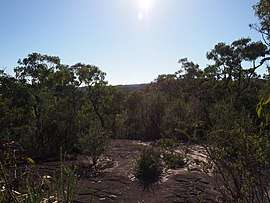Kariong, New South Wales
Kariong is a locality of the Central Coast region of New South Wales, Australia west of Gosford along the Central Coast Highway. It is part of the Central Coast Council local government area.
.jpg)
| Kariong Central Coast, New South Wales | |
|---|---|
 | |
| Population | 6,385 (2016 census)[1] |
| Postcode(s) | 2250 |
| Location | 7 km (4 mi) WSW of Gosford |
| LGA(s) | Central Coast Council |
| Parish | Patonga |
| State electorate(s) | Gosford |
| Federal Division(s) | Robertson |
History
Kariong's first British settler was W.H. Parry in 1901. The Mt Penang Training School for Boys (later the Mount Penang Juvenile Justice Centre) was opened in 1911. Many of the boys came from the training ship Sobraon, which had been in Sydney Harbour before being condemned, as did former officer Basil Topple. The village of about fifteen families, mostly workers at the training school, was first called Kendall Heights, then Penang Mountain. The name Kariong was assigned in about 1947.
Etymology
Kariong was once believed to mean meeting place in the local Aboriginal language. Other early residents were told the name meant "place of the cold winds", and the name is listed, albeit with a different spelling, in F.D. McCarthy's Australian Aboriginal place names book of 1946 with this meaning. However, records in the NSW Mitchell Library show that the name Kariong was a typographical error from old script reading 'Karrong'; the second 'r' was mistaken for an 'i'.
Geography
Kariong's boundaries include a considerable section of the Brisbane Water National Park to the south, and the Mount Penang Parklands, with its native gardens. Kariong is considered the entry point to the Central Coast as it borders the Pacific Motorway M1. A visitor information centre for the Central Coast is located just off the Central Coast Highway, near the entry to the Mount Penang Parklands.
Population
According to the 2016 census of Population, there were 6,385 people in Kariong.
- Aboriginal and Torres Strait Islander people made up 3.6% of the population.
- 77.7% of people were born in Australia. The next most common countries of birth was England 5.0% and New Zealand 2.3%.
- 86.0% of people spoke only English at home.
- The most common responses for religion were No Religion 30.6%, Catholic 21.2% and Anglican 20.3%.[1]
Kariong Mountains High School opened in 2010 at Kariong.
Gosford glyphs
The Gosford glyphs are a group of approximately 300 pseudo-Egyptian hieroglyphs in an area known for its Aboriginal petroglyphs. They are carved into two parallel sandstone walls about 15 m (49 ft) long. They depict boats, chickens, dogs, owls, stick men, a dog's bone as well as two that appear to be the names of kings, one of them Khufu, the other uncertain. These names are given the same personal name and throne name. There is also a carving of the ancient Egyptian god Anubis.[2] These were first reported in 1975 by Alan Dash, a local surveyor who had been visiting the area for seven years. Dash continued to visit for five years and reported that the number of hieroglyphs had increased every time that he visited.[2]
Since then the hieroglyphs have been claimed by amateur Egyptologists to be authentic script carved by ancient Egyptians about 4,500 years ago, but scholar, Professor Ockinga, said "there are many reasons why they are not accepted as genuine hieroglyphics..."First of all the way they're cut is not the way ancient Egyptian rock inscriptions are produced, they're very disorganised..."There's also a problem with the actual shapes of the signs that are used. There's no way people would've been inscribing texts from the time of Cheops from the signs that weren't invented until 2500 years later." He suggested that the glyphs might have been made in the 1920s by Australian soldiers who had served in Egypt, citing an example of shapes in the form of the Sphinx and a pyramid known to have been made by a returning soldier.[3] Australian Professor of Egyptology Naguib Kanawati has also stated that they are not authentic,[4] saying that the hieroglyphs within the same panels were of widely different periods and some were carved backwards.[5]
Geologists have stated that the sandstone in which the hieroglyphs are carved erodes quickly and nearby 250-year-old Aborigine petroglyphs show considerably more erosion.[5] In 1983, David Lamber, then a rock art conservator for the National Park Wildlife Service, found some clean cut hieroglyphs which he estimated to be less than twelve months old.[2]
References
- Australian Bureau of Statistics (27 June 2017). "Kariong (NSW)". 2016 Census QuickStats. Retrieved 2 September 2019.


- Coltheart, David (October–November 2003). "Debunking The Gosford Glyphs". Archaeological Diggins. 10 (5).
- "Egyptologist debunks new claims about 'Gosford glyphs'". ABC News. 14 December 2012. Retrieved 7 December 2014.
- Kelly, Matthew (20 October 2012). "Ancient Egyptians lived near Woy Woy: fact or fantasy?". Newcastle Herald. Retrieved 7 December 2014.
- Kenneth L. Feder, Encyclopedia of Dubious Archaeology: From Atlantis To The Walam Olum, page 120-121(Greenwood, 2010). ISBN 978-0-313-37919-2